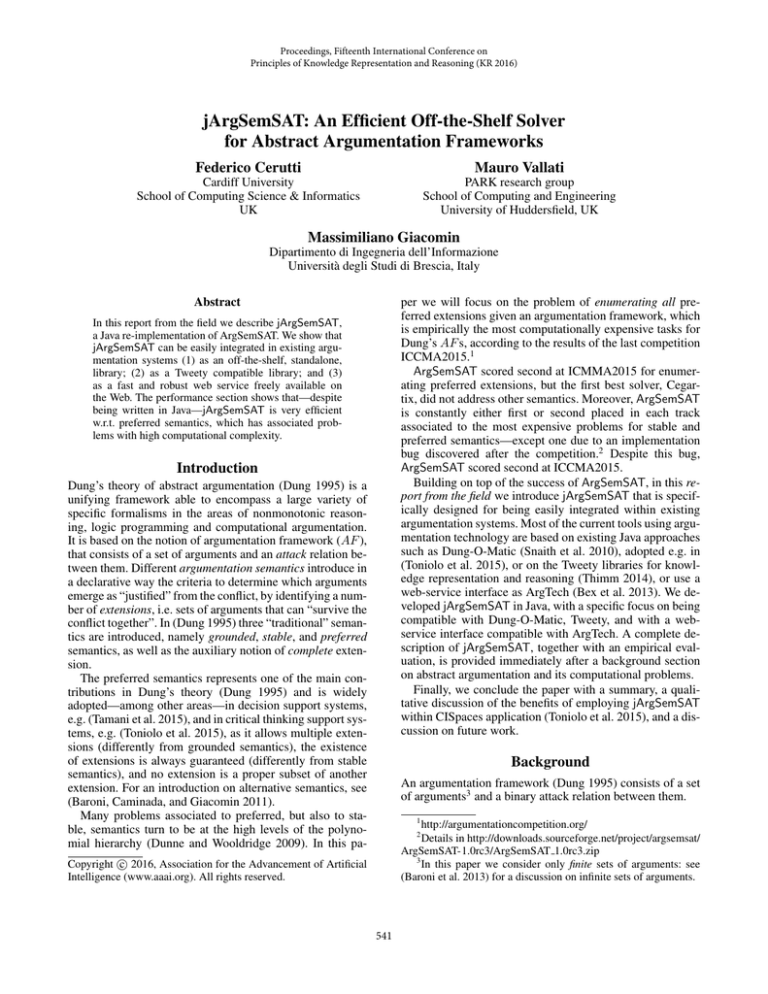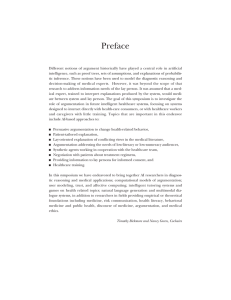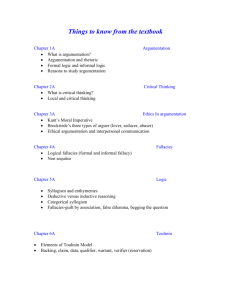
Proceedings, Fifteenth International Conference on
Principles of Knowledge Representation and Reasoning (KR 2016)
jArgSemSAT: An Efficient Off-the-Shelf Solver
for Abstract Argumentation Frameworks
Federico Cerutti
Mauro Vallati
Cardiff University
School of Computing Science & Informatics
UK
PARK research group
School of Computing and Engineering
University of Huddersfield, UK
Massimiliano Giacomin
Dipartimento di Ingegneria dell’Informazione
Università degli Studi di Brescia, Italy
per we will focus on the problem of enumerating all preferred extensions given an argumentation framework, which
is empirically the most computationally expensive tasks for
Dung’s AF s, according to the results of the last competition
ICCMA2015.1
ArgSemSAT scored second at ICMMA2015 for enumerating preferred extensions, but the first best solver, Cegartix, did not address other semantics. Moreover, ArgSemSAT
is constantly either first or second placed in each track
associated to the most expensive problems for stable and
preferred semantics—except one due to an implementation
bug discovered after the competition.2 Despite this bug,
ArgSemSAT scored second at ICCMA2015.
Building on top of the success of ArgSemSAT, in this report from the field we introduce jArgSemSAT that is specifically designed for being easily integrated within existing
argumentation systems. Most of the current tools using argumentation technology are based on existing Java approaches
such as Dung-O-Matic (Snaith et al. 2010), adopted e.g. in
(Toniolo et al. 2015), or on the Tweety libraries for knowledge representation and reasoning (Thimm 2014), or use a
web-service interface as ArgTech (Bex et al. 2013). We developed jArgSemSAT in Java, with a specific focus on being
compatible with Dung-O-Matic, Tweety, and with a webservice interface compatible with ArgTech. A complete description of jArgSemSAT, together with an empirical evaluation, is provided immediately after a background section
on abstract argumentation and its computational problems.
Finally, we conclude the paper with a summary, a qualitative discussion of the benefits of employing jArgSemSAT
within CISpaces application (Toniolo et al. 2015), and a discussion on future work.
Abstract
In this report from the field we describe jArgSemSAT,
a Java re-implementation of ArgSemSAT. We show that
jArgSemSAT can be easily integrated in existing argumentation systems (1) as an off-the-shelf, standalone,
library; (2) as a Tweety compatible library; and (3)
as a fast and robust web service freely available on
the Web. The performance section shows that—despite
being written in Java—jArgSemSAT is very efficient
w.r.t. preferred semantics, which has associated problems with high computational complexity.
Introduction
Dung’s theory of abstract argumentation (Dung 1995) is a
unifying framework able to encompass a large variety of
specific formalisms in the areas of nonmonotonic reasoning, logic programming and computational argumentation.
It is based on the notion of argumentation framework (AF ),
that consists of a set of arguments and an attack relation between them. Different argumentation semantics introduce in
a declarative way the criteria to determine which arguments
emerge as “justified” from the conflict, by identifying a number of extensions, i.e. sets of arguments that can “survive the
conflict together”. In (Dung 1995) three “traditional” semantics are introduced, namely grounded, stable, and preferred
semantics, as well as the auxiliary notion of complete extension.
The preferred semantics represents one of the main contributions in Dung’s theory (Dung 1995) and is widely
adopted—among other areas—in decision support systems,
e.g. (Tamani et al. 2015), and in critical thinking support systems, e.g. (Toniolo et al. 2015), as it allows multiple extensions (differently from grounded semantics), the existence
of extensions is always guaranteed (differently from stable
semantics), and no extension is a proper subset of another
extension. For an introduction on alternative semantics, see
(Baroni, Caminada, and Giacomin 2011).
Many problems associated to preferred, but also to stable, semantics turn to be at the high levels of the polynomial hierarchy (Dunne and Wooldridge 2009). In this pa-
Background
An argumentation framework (Dung 1995) consists of a set
of arguments3 and a binary attack relation between them.
1
http://argumentationcompetition.org/
Details in http://downloads.sourceforge.net/project/argsemsat/
ArgSemSAT-1.0rc3/ArgSemSAT 1.0rc3.zip
3
In this paper we consider only finite sets of arguments: see
(Baroni et al. 2013) for a discussion on infinite sets of arguments.
2
c 2016, Association for the Advancement of Artificial
Copyright Intelligence (www.aaai.org). All rights reserved.
541
jArgSemSAT is freely (MIT licence) available on SourceForge4 and as Maven projects directly accessible from the
central repository.5 It is composed by two jar files and a
war file.
jArgSemSAT-VERSION.jar provides both the standalone application compatible with the Probo interface and
the DoM compatible library: we chose not to distribute the
library without the Probo interface to facilitate future experiments also from different research groups and to improve
the awareness in the community of the ICCMA competition.
jArgSemSATTweety-VERSION.jar is a selfcontained, Tweety-compatible, library: it includes
jArgSemSAT-VERSION.jar and provides a Tweetycompatible interface.
jArgSemSATWeb-VERSION.war is a self-contained
Tomcat 6 web-service archive compatible with ArgTech7
specifications. This web-service is also available free-ofcharge—with best effort SLA—at http://cicero.cs.cf.ac.uk/
jArgSemSATWeb/restapi/argtech/ . Its source code is also
freely available.
Definition 1. An argumentation framework (AF ) is a pair
Γ = A, R where A is a set of arguments and R ⊆ A × A.
We say that b attacks a iff b, a ∈ R, also denoted as b → a.
Each argumentation framework has an associated directed
graph where the vertices are the arguments, and the edges
are the attacks.
The basic properties of conflict–freeness, acceptability,
and admissibility of a set of arguments are fundamental for
the definition of argumentation semantics.
Definition 2. Given an AF Γ = A, R:
• a set S ⊆ A is a conflict–free set of Γ if a, b ∈ S s.t.
a → b;
• an argument a ∈ A is acceptable with respect to a set
S ⊆ A of Γ if ∀b ∈ A s.t. b → a, ∃ c ∈ S s.t. c → b;
• a set S ⊆ A is an admissible set of Γ if S is a conflict–free
set of Γ and every element of S is acceptable with respect
to S.
An argumentation semantics σ prescribes for any AF Γ
a set of extensions, denoted as Eσ (Γ), namely a set of sets
of arguments satisfying the conditions dictated by σ. A preferred extension is a maximal (w.r.t. set inclusion) admissible set.
Definition 3. Given an AF Γ = A, R, a set S ⊆ A is a
preferred extension of Γ, i.e. S ∈ EPR (Γ), iff S is a maximal
(w.r.t. set inclusion) admissible set of Γ.
Enumerating the set of preferred extensions lies at the second level of the polynomial hyerarchy, Πp2 .
1. Stand-alone application jArgSemSAT exports the
same command line interface of ArgSemSAT, which is a
superset of the Probo interface. In addition to the options
discussed in (Cerutti et al. 2014b), jArgSemSAT allows the
user to choose (1) the SAT solver to be used; and (2) the
encoding to use.
As for the SAT solver, jArgSemSAT allows the user
to choose any desired SAT solver—whose full path must
be provided—that supports the DIMACS format, accepts a
CNF from the STDIN, and returns a model to the STDOUT.
In order to provide an off-the-shelf solver, jArgSemSAT also
integrates as a library Sat4j (Le Berre and Parrain 2010).
Sat4j8 is an open source library which allows Java programmers to access cross-platform SAT-based solvers.
With respect to the encoding to be used for generating the SAT formulae, jArgSemSAT provides as default
the same encoding that has been proven to be the best for
ArgSemSAT.
System design and cases-study
jArgSemSAT and ArgSemSAT enumerate preferred extensions by multiple calls to a SAT solver (Cerutti et al. 2014a).
A propositional formula over a set of Boolean variables is
satisfiable iff there exists a truth assignment of the variables
such that the formula evaluates to True. Checking whether
such an assignment exists is the satisfiability (SAT) problem.
The solvers exploit an encoding of complete extensions as a
propositional formula in Conjunctive Normal Form (CNF)
and apply a filtering procedure over the space of complete
extensions to select the maximal ones, i.e. the preferred extensions.
jArgSemSAT is a mature application that now exists in
four different versions:
1. Stand-alone application: this guarantees compatibility
with the Probo interface for the International Competition on Computational Models of Argumentation (ICCMA) (Cerutti et al. 2014b);
2. Dung-O-Matic (DoM) (Snaith et al. 2010) compatible library: this ensures compatibility for works already using
DoM such as CISpaces (Toniolo et al. 2015);
3. Tweety (Thimm 2014) compatible library: we proudly
support the Tweety project whose aim is to provide a general framework for implementing and testing knowledge
representation formalisms;
4. ArgTech (Bex et al. 2013) compatible web-service: we
created a Tomcat web-service exporting jArgSemSAT
with ArgTech-compatible RESTful interfaces.
2.
Dung-O-Matic
(DoM)
compatible
library
jArgSemSAT exports methods whose signature are
compatible with Dung-O-Matic (Snaith et al. 2010): those
methods encapsulate the code for calling jArgSemSAT with
the default configurations, and on data-structures that reside
on memory instead on a file.
Therefore, the following snippet code:
Vector<String> args
= new Vector<String>();
args.add("a");
args.add("b");
Vector<String []> atts
= new Vector<String []>();
atts.add(new String []{"a", "b"});
4
https://sourceforge.net/projects/jargsemsat/
http://search.maven.org/
6
http://tomcat.apache.org/
7
http://ws.arg.tech/
8
http://www.sat4j.org/
5
542
new DungAF(args, atts).getStableExts();
is valid if either DoM or jArgSemSAT library is imported.
% success
% best
PAR10
3. Tweety compatible library In order to guarantee
the full compatibility with the Tweety libraries (Thimm
2014), and to reduce the burden on programmers already using them, jArgSemSATTweety extends the
net.sf.tweety.arg.dung.GroundReasoner,
net.sf.tweety.arg.dung.PreferredReasoner,
and net.sf.tweety.arg.dung.StableReasoner,
overriding only the method computeExtensions in
each of them. As for the DoM compatible library,
jArgSemSAT uses the default configurations only.
• attacks,
type
String
["(A,B)", "(B,Arg_1)"];
Array,
Array,
• semantics, type String, one of
preferred, stable, semistable.9
ArgSemSAT
99.5
65.6
81.7
Table 1: Performance achieved by jArgSemSAT exploiting either Sat4j or glucose3.0, and ArgSemSAT on the ICCMA2015 benchmarks. Results are shown in terms of percentages of success, percentages of AF s in which the system
has been the fastest and PAR10. Values in bold indicate the
best results.
4. ArgTech compatible web-service As presented in http:
//ws.arg.tech/, the ArgTech (Bex et al. 2013) web-service
solver for abstract argumentation problems requires a POST
message with the following fields:
• arguments,
type
String
["A","B", "Arg_1"];
jArgSemSAT
Sat4j
glucose3.0
97.9
99.5
13.5
9.9
256.7
97.2
selection, and portfolio construction, because PAR score allows runtime to be considered while still placing a strong
emphasis on coverage.
jArgSemSAT can exploit any SAT solver that supports the
DIMACS format. In this analysis we considered the Javabased SAT solver Sat4j—which guarantees high portability and easy usage— and glucose3.0 (Audemard and Simon
2014) that is written in C++.
We are aware that the exploitation of a C++ software can
pose some strong portability issues, mainly due to compilers and libraries, but C++ solvers are generally believed to
be faster than corresponding Java-based systems. Therefore,
here we are interested in measuring such performance gap,
in order to make jArgSemSAT users aware of the importance of the solver. However, it should be noted that Sat4j
has been included in the overall jArgSemSAT framework,
while glucose3.0 has to be executed through PIPE communication system among processes.
Table 1 shows the results of the comparison between
jArgSemSAT exploiting the mentioned SAT solvers, and
ArgSemSAT. As a first note, we observe that the performance gap between ArgSemSAT and jArgSemSAT is not
remarkable, particularly in terms of percentage of successfully analysed frameworks. Beside this, the main conclusion that can be derived from Table 1 is that the use of glucose3.0 does not provide a significant performance improvement. The use of the C++ SAT solver allows jArgSemSAT
to successfully analyse a few more benchmark frameworks,
but the exploitation of Sat4j allows to quickly solve a larger
number of AF .
Surprisingly, the performance of considered SAT solvers
are not directly related to the number of preferred extensions, i.e. there is no direct relation between the number
of times the solver is called by jArgSemSAT and the runtime. This means that the overhead added by the PIPE communication is negligible and does not impact on the performance of jArgSemSAT. On the other hand, Sat4j improves the performance of jArgSemSAT on AF s that can be
solved in less than—approximately—50 CPU-time seconds;
on more complex AF s, the use of glucose3.0 is usually beneficial. The ability of glucose3.0 to handle empirically complex AF s, is confirmed by the fact that the use of glucose3.0
allows jArgSemSAT to solve, within the given time, a few
more AF s from the considered ICCMA2015 benchmark.
e.g.
e.g.
grounded,
For instance, the following JSon structure
{"arguments":["a","b"],
"attacks":["(a,b)"],
"semantics":"stable"}
is a valid POST request for jArgSemSATWeb.
jArgSemSAT is then invoked with the default configurations only.
Empirical Evaluation
This experimental analysis is focused on comparing the
performance of jArgSemSAT with the performance of
ArgSemSAT (Cerutti, Giacomin, and Vallati 2014), in order
to provide a good overview of the performance gap between
the Java-based proposed system and the more efficient C++
implementation. The experiments were performed on a cluster with computing nodes equipped with 2.4 Ghz processors,
4 GB of RAM and Linux operating system. A cutoff of 900
seconds was imposed for analysing a single AF . We considered the ICCMA2015 benchmark set, which is a set of
192 randomly generated AF s. Here we focused on the empirically most computationally expensive tasks, according to
the results of ICCMA2015, i.e. preferred extensions enumeration.
The Penalised Average Runtime (PAR score) has been
used for comparing solvers’ performance. PAR is a real
number which counts (i) runs that fail to solve the considered problem as ten times the cutoff time (PAR10) and (ii)
runs that succeed as the actual runtime. PAR scores are commonly used in automated algorithm configuration, algorithm
To ensure full compatibility, jArgSemSAT contains an experimental implementation of an algorithm for enumerating semistable extensions, cf. Conclusion.
9
543
Conclusion
References
In this paper we present jArgSemSAT, an efficient off-theshelf solver for abstract argumentation problems. In the
previous sections we give evidence of how jArgSemSAT
is compatible with the current off-the-shelf solver, namely
Dung-O-Matic (Snaith et al. 2010), and with the Tweety
libraries (Thimm 2014); exists in a web-service version
compatible with ArgTech technologies (Bex et al. 2013)—
and we made it freely available at http://cicero.cs.cf.ac.uk/
jArgSemSATWeb/restapi/argtech/—; and it is only slightly
less efficient than its ancestor ArgSemSAT, which is written
in C++.
Currently, jArgSemSAT is used within CISpaces (Toniolo
et al. 2015) that has been our main use-case. CIspaces (Collaborative Intelligence Spaces) is a tool mostly written in
Java—only the GUI is written in Python—to help analysts in
acquiring, evaluating and interpreting information. Indeed,
the aim of intelligence analysis is to make sense of information that is often conflicting or incomplete, and to weigh
competing hypotheses that may explain a situation. This imposes a high cognitive load on analysts, and there are few
automated tools to aid them in their task. CISpaces assists
analysts in reasoning with different types of evidence: analysts are supported in structuring evidence using argumentation schemes, and in identifying plausible hypotheses via
the computation of preferred extensions.
By adopting jArgSemSAT CISpaces now computes the
preferred extensions of average analysis almost instantaneously. Moreover, jArgSemSAT allows CISpaces to use its
probabilistic argumentation engine in real analysis. Indeed,
CIspaces includes a probabilistic argumentation engine (Li,
Oren, and Norman 2012; Li 2015) that heavily resides on
preferred extensions computed on probabilistic manipulation of AF s. Therefore, the preferred extension enumeration solver needs to be invoked an exponential number of
times. Dung-O-Matic limited the use of the probabilistic argumentation engine to toy examples; jArgSemSAT makes it
available for real analysis.
The future of jArgSemSAT, in our view, lays in supporting all the research community to build argumentation-based
tools. That is the reason that motivated us in providing a
free-of-charge, but clearly with best-effort only SLA, webservice interface to jArgSemSAT. From a technical perspective, we need to ultimate the technical documentation and we
plan to include support for the remaining semantics, notably
semi-stable (Caminada 2006)—that is already supported in
an experimental, non-optimised version.
Acknowledgments
The authors thank (in alphabetical order) Prof. Chris Reed
and Dr. Mark Snaith—University of Dundee—for their
support in ensuring compatibility between jArgSemSAT
and existing technologies at ArgTech. Moreover, we thank
Dr. Matthias Thimm—Universität Koblenz-Landau—for his
support in integrating jArgSemSAT with Tweety, and Dr.
Alice Toniolo—University of Aberdeen—for integrating
jArgSemSAT within CISpaces. The authors would like to
acknowledge the use of the University of Huddersfield
Queensgate Grid in carrying out this work.
Audemard, G., and Simon, L. 2014. Lazy clause exchange
policy for parallel sat solvers. In SAT 2014. 197–205.
Baroni, P.; Cerutti, F.; Dunne, P. E.; and Giacomin, M. 2013.
Automata for Infinite Argumentation Structures. Artificial
Intelligence 203(0):104–150.
Baroni, P.; Caminada, M.; and Giacomin, M. 2011. An
introduction to argumentation semantics. Knowledge Engineering Review 26(4):365–410.
Bex, F.; Lawrence, J.; Snaith, M.; and Reed, C. 2013. Implementing the argument web. Communications of the ACM
56(10):66.
Caminada, M. 2006. Semi-Stable Semantics. In COMMA
2006, 121–130.
Cerutti, F.; Dunne, P. E.; Giacomin, M.; and Vallati, M.
2014a. Computing Preferred Extensions in Abstract Argumentation: A SAT-Based Approach. In TAFA 2013, LNCS.
176–193.
Cerutti, F.; Oren, N.; Strass, H.; Thimm, M.; and Vallati,
M. 2014b. A Benchmark Framework for a Computational
Argumentation Competition. In COMMA 2014, 459–460.
Cerutti, F.; Giacomin, M.; and Vallati, M. 2014. ArgSemSAT: Solving Argumentation Problems Using SAT. In
COMMA 2014, 455–456.
Dung, P. M. 1995. On the Acceptability of Arguments and
Its Fundamental Role in Nonmonotonic Reasoning, Logic
Programming, and n-Person Games. Artificial Intelligence
77(2):321–357.
Dunne, P. E., and Wooldridge, M. 2009. Complexity of
abstract argumentation. In Argumentation in AI. SpringerVerlag. chapter 5, 85–104.
Le Berre, D., and Parrain, A. 2010. The Sat4j library, release
2.2 system description. Journal on Satisfiability, Boolean
Modeling and Computation 7(2010):59–64.
Li, H.; Oren, N.; and Norman, T. 2012. Probabilistic Argumentation Frameworks. In Theorie and Applications of
Formal Argumentation, LNCS. 1–16.
Li, H. 2015. Probabilistic Argumentation. Ph.D. Dissertation, U. Aberdeen.
Snaith, M.; Devereux, J.; Lawrence, J.; and Reed, C. 2010.
Pipelining argumentation technologies. In COMMA 2010,
447–453.
Tamani, N.; Mosse, P.; Croitoru, M.; Buche, P.; Guillard, V.;
Guillaume, C.; and Gontard, N. 2015. An argumentation
system for eco-efficient packaging material selection. Computers and Electronics in Agriculture 113:174–192.
Thimm, M. 2014. Tweety - a comprehensive collection of
java libraries for logical aspects of artificial intelligence and
knowledge representation. In KR’14, 528–537.
Toniolo, A.; Norman, T. J.; Etuk, A.; Cerutti, F.; Ouyang,
R. W.; Srivastava, M.; Oren, N.; Dropps, T.; Allen, J. A.; and
Sullivan, P. 2015. Agent Support to Reasoning with Different Types of Evidence in Intelligence Analysis. In AAMAS
2015, 781—-789.
544






